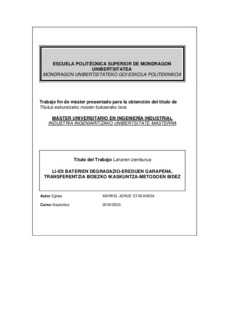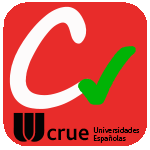
Ikusi/
Izenburua
Li-ioi baterien degradazio-ereduen garapena, transferentzia bidezko ikaskuntza-metodoen bidezEgilea
Argitalpen data
2020Argitaratzailea
Mondragon Unibertsitatea. Goi Eskola PoliteknikoaGako-hitzak
Máster universitario en Ingeniería Industrial2019/2020
MU-Mondragon Saria (Ikasketa Amaierako Lanak euskaraz)
Laburpena
Li-ioi bateriak garestiak dira eta degradatu egiten dira; hori dela eta, degradazio-eredu bat sortu beharra dago, bateriek xede-aplikazioan zer portaera izango duten eta zenbat iraungo duten simulatze ... [+]
Li-ioi bateriak garestiak dira eta degradatu egiten dira; hori dela eta, degradazio-eredu bat sortu beharra dago, bateriek xede-aplikazioan zer portaera izango duten eta zenbat iraungo duten simulatzeko. Ereduok sortzeko, bateriak hainbat baldintzatan frogatu behar dira laborategian. Frogok garestiak dira eta denbora luze hartzen dute; hortaz, laborategiko froga gutxiago egin behar izateko metodo bat bilatu beharra dago. Horretarako, lan honetan, adimen artifizialeko algoritmoak erabiltzea proposatzen da; horien helburua da, bada, baterien degradazioa iragartzea. Behar den entsegu kopurua murrizteko transferentzia bidezko ikaskuntza-teknika erabiltzea proposatzen da. Horren bidez, sare neuronal batek jatorri-ataza batean ikasitakoa erabil dezake xede-atazako helburuak hobetzeko. Horretarako, bi Li-ioi kimikaren datu multzoak erabili dira: NMC eta LFP. Lehenengoa sare neuronala jatorri-atazan entrenatzeko erabili da. Ondoren, sare neuronal hori erabili ahal izan da, transferentzia bidezko ikaskuntza aplikatuta, bigarren Li-ioi bigarren kimikaren degradazioa iragartzeko, bigarren datu multzoko datu gutxi batzuk baliatuta. Hartara, nabarmen txikitu da LFP baterietarako degradazio-eredua garatzeko kostua. Proposatutako metodoa Li-ioi baterietarako degradazio-eredu unibertsalak garatzeko lehen urratsa da, hautatutako kimika gorabehera. Beraz, memoria honetan aurkeztutako ikerketa-lanak interes teknologikoa ez ezik, interes ekonomikoa ere badu, eta energia-biltegiratzearen mendeko industria-esfera osoaren egungo eta erorkizuneko erronkei erantzuten die. [-]
The cost and degradation of Li-ion batteries make necessary to develop degradation models that simulate how the batteries will behave and how long they will last in the target application. To develop ... [+]
The cost and degradation of Li-ion batteries make necessary to develop degradation models that simulate how the batteries will behave and how long they will last in the target application. To develop such models, it is necessary to test the batteries in different operating conditions in a laboratory environment. Such tests are time and cost-intensive. Therefore, it is necessary to find a method which allows minimizing laboratory tests. In this work, artificial intelligence algorithms are used to predicting the degradation of batteries. With the purpose of minimizing the necessary number of tests, transfer learning techniques are used, which allow a neural network to use the knowledge acquired in a source task to improve the results in the target task. For this purpose, two data sets from two different chemistries of Li-ion, NMC and LFP, will be used. The first one will be used to train the neural network in the source task. Then, to be able to predict the degradation of the second Li-ion chemistry, transfer learning technique will be applied, retraining the neural network using a few data from the second data set. This way, it is possible to significantly reduce the development cost of the degradation model for LFP batteries. The proposed method represents the first step towards the development of universal degradation models for Li-ion batteries, independent of the selected chemistry. Therefore, the research work presented in this report has not only a technological but also an economic interest, and responds to the current and future challenges of the entire industrial sphere dependent on energy storage. [-]
El costo y la degradación de las baterías de Li-ion hacen que sea necesario crear un modelo de degradación que simule cómo se comportarán y cuánto durarán las baterías en la aplicación de destino. Par ... [+]
El costo y la degradación de las baterías de Li-ion hacen que sea necesario crear un modelo de degradación que simule cómo se comportarán y cuánto durarán las baterías en la aplicación de destino. Para crear dichos modelos es necesario testear las baterías en diversas condiciones en un laboratorio. Esas pruebas son costosas y requieren mucho tiempo, por lo que se ve necesario buscar un método que permita minimizar los ensayos de laboratorio. Para ello, en este trabajo se propone utilizar algoritmos de inteligencia artificial, orientados a predecir la degradación de las baterías. Con el objetivo de minimizar el número necesario de ensayos, se propone utilizar la técnica del aprendizaje por transferencia, que permite que una red neuronal utilice el conocimiento adquirido en una tarea de origen para mejorar los resultados en la tarea objetivo. Con ese fin, se han utilizado dos sets de datos de dos químicas diferentes de Li-ion, NMC y LFP. La primera es la que se ha empleado para entrenar la red neuronal en la tarea de origen, para después poder utilizar esa red neuronal aplicando el aprendizaje por transferencia y así poder predecir la degradación de la segunda quimica de Li-ion utilizando unos pocos datos del segundo set. De este modo, se consigue reducir de forma significativa el coste de desarrollo del modelo de degradación para baterías LFP. El método propuesto representa el primer paso hacia el desarrollo de modelos de degradación universales para baterías de Li-ion, independientemente de la química seleccionada. Por lo tanto, el trabajo de investigación presentado en esta memoria no solo tiene un interés tecnológico, sino también económico, y responde a los retos actuales y futuros de toda la esfera industrial dependiente del almacenamiento de la energía. [-]




















